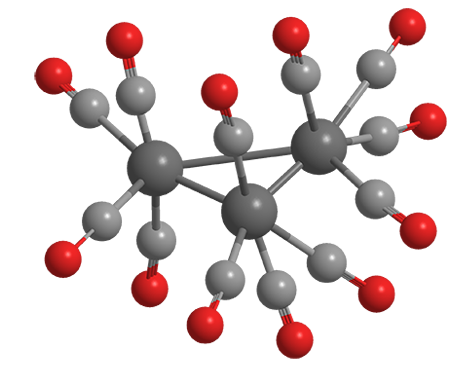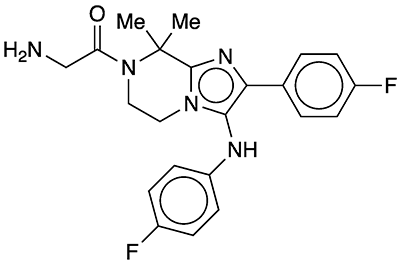What molecule am I?


Triruthenium dodecacarbonyl [Ru3(CO)12] is a coordination compound that consists of a triangle of ruthenium atoms, each of which is bonded to four carbon monoxide molecules. It appears as dark orange crystals that are soluble in nonpolar solvents but not in water.
Ru3(CO)12 and the similar osmium dodecacarbonyl1 [Os3(CO)12] were originally reported to have the formulas Ru2(CO)9 and Os2(CO)9, respectively. But an extensive analysis in 1961 by Eugene E. Corey and Lawrence F. Dahl* at the University of Wisconsin (Madison) revealed the previously unforeseen trigonal structures of the molecules. The authors used crystallographic and spectroscopic evidence to establish the molecular structures.
Ru3(CO)12 is synthesized via the base-catalyzed liquid-phase reaction of ruthenium trichloride2 (RuCl3) with CO. It also has been made under high CO pressure from ruthenium stearate3 dissolved in cyclohexane or from RuCl3 and metallic zinc in ethanol.
The primary use for Ru3(CO)12 is the synthesis of other ruthenium complexes, many with CO combined with other ligands such as alkenes. Two recent patents to Tokyo Electron Ltd. (Tokyo) describe its use for making ruthenium films deposited on silicon substrates that form semiconductors.
This year, Ru3(CO)12 has also been used for an educational purpose. It, along with six other inorganic molecules with varying types of symmetry, were examples used by Donald J. Wink and collaborators at the University of Illinois Chicago to instruct students to recognize symmetry elements. The activity included student-created 2-D drawings and 3-D molecular models.
Considering that CO and most ruthenium compounds are highly toxic, Ru3(CO)12 exhibits remarkably few hazards.
1. CAS Reg. No. 15696-40-9.
2. CAS Reg. No. 10049-08-8.
3. CAS Reg. No. 153728-81-5.
Triruthenium dodecacarbonyl hazard information
| Hazard class* | GHS code and hazard statement | |
|---|---|---|
| Acute toxicity, inhalation, category 4 | H332—Harmful if inhaled | |
*Globally Harmonized System (GHS) of Classification and Labeling of Chemicals. Explanation of pictograms.
Molecule of the Future
Ganaplacide1 is an antimalarial agent in the imidazolopiperazine family that is being developed by Novartis (Basel, Switzerland) with support from the Medicine for Malaria Venture (MMV), a multinational nonprofit organization. New drugs are needed because artemisinin2, artemether3, and other treatments are becoming resistant to malaria-causing parasites.

In 2012, Arnab K. Chatterjee at Novartis’s Genomics Institute (San Diego) and colleagues there and at Novartis facilities in Cambridge, MA, and Singapore; the Swiss Tropical and Public Health Institute (Basel); and the University of Basel reported the lead optimization of imidazolopiperazine candidates to replace current drugs. Ganaplacide was eventually chosen as the molecule for development; and in November 2022, Novartis and MMV announced that it, in combination with lumefantrine4 (a compound previously used with artemether), would transition to a Phase 3 study for treating patients with acute uncomplicated malaria. The study was scheduled to begin this year.
1. CAS Reg. No. 1261113-96-5.
2. CAS Reg. No. 63968-64-9.
3. CAS Reg. No. 71963-77-4.
4. CAS Reg. No. 82186-77-4.
Molecule of the Future
Once a month we bring you a newly discovered or developed molecule that has important implications for the future of chemistry or society in general. Look for it the third week of each month. Learn more about this month's Molecule of the Future below.
We're looking for more molecules of the future!
Do you have a suggestion for the next molecule of the future? Send your idea to MOTW.
This molecule was suggested by a reader. We present almost all of the molecules suggested by our readers. If you have a molecule you would like us to consider, please send us a message. And thank you for your interest in Molecule of the Week! —Ed.
Triruthenium dodecacarbonyl Fast Facts
| CAS Reg. No. | 15243-33-1 |
| SciFinder nomenclature | Ruthenium, dodecacarbonyltri-, triangulo |
| Empirical formula | C12O12Ru3 |
| Molar mass | 639.33 g/mol |
| Appearance | Orange crystals or powder |
| Melting point | 150 °C (dec.)a |
| Water solubility | Insoluble |
a. Also reported as 224 °C without decomposition.
MOTW update
Ellagic acid1 was the Molecule of the Week for January 23, 2003. It is a natural polyphenol that was originally used in tanning agents; but more recently, it has shown potential health benefits such as treating breast cancer and gut inflammation. This month, Ruili Yang and co-workers at South China Agricultural University (Guangzhou) reported that ellagic acid, by metabolizing to urolithin A2, slows aging in rats by reducing cognitive impairment, increasing γ-aminobutyric acid and serotonin levels, and suppressing inflammatory and oxidative stress.
1. CAS Reg. No. 476-66-4.
2. CAS Reg. No. 1143-70-0.

Learn more about this molecule from CAS, the most authoritative and comprehensive source for chemical information.
Molecule of the Week needs your suggestions!
If your favorite molecule is not in our archive, please send us a message. The molecule can be notable for its current or historical importance or for any quirky reason. Thank you!
Stay Ahead of the Chemistry Curve
Learn how ACS can help you stay ahead in the world of chemistry.

